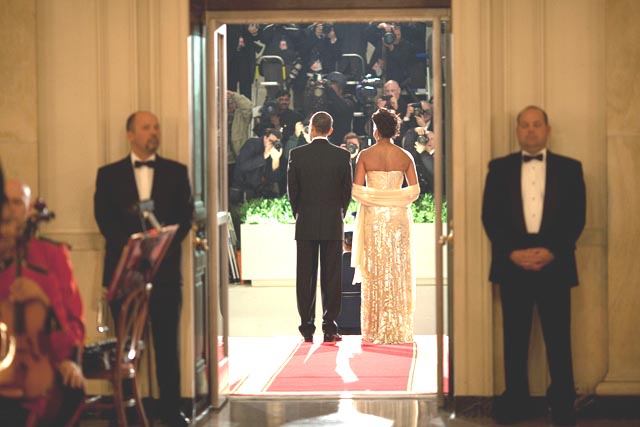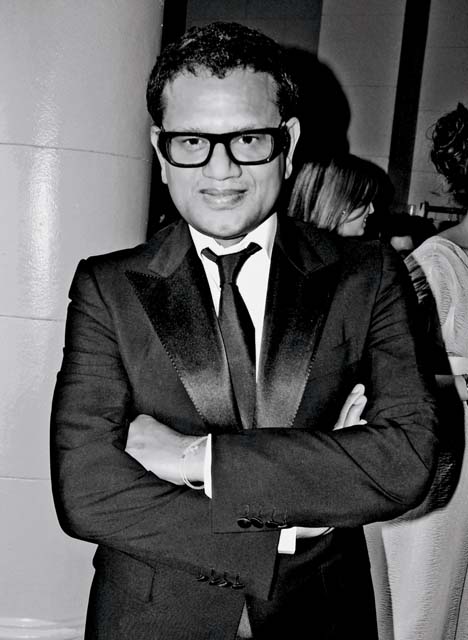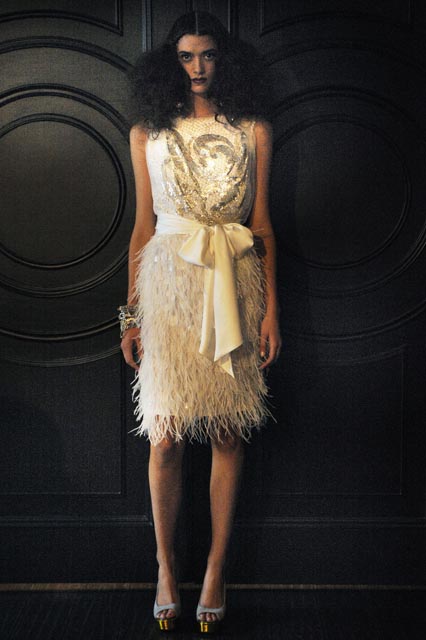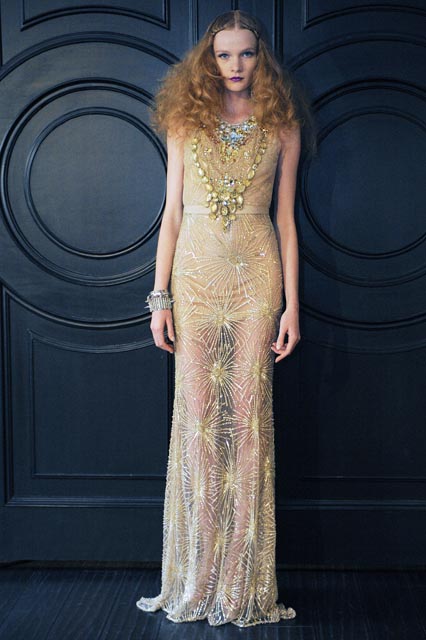
A visit to Naeem Khan’s penthouse showroom is like being transported into a different world. It’s embedded in the bustling garment district of New York with its countless wholesale showrooms, and you see racks of dresses and the occasional store mannequin being ferried on the crowded pavements. Ascend to Khan’s 10th floor showroom, and you are in an 18,000 foot space with soaring ceilings and a touch of 30’s Hollywood.
Stroll into his workshop and you see dozens of workers, craftspeople and pattern makers going about their work. Khan likes to call it his lab.
His own office overlooks the garment district – peer out of the vast bare windows around evening and the tall buildings across the street look like a jewel-box, a miniature doll house with people in lit-up windows working with fabric, stitching and going about the business of dressing New York.
Ever since the news broke that he was designing First Lady Michelle Obama’s gown for the State Dinner in honor of Prime Minister Manmohan Singh, Khan’s phone hasn’t stopped ringing. Now with the passing of a few weeks, I managed to have a face-to-face chat with him, asking him of course, about the famous dress.

“It should be classical, glamorous, and timeless – but still have India in it,” he says, recalling the way he visualized it. He was asked to design one piece – he designed six and sent to the First Lady so she could pick the one she liked best.
“The idea is how do you make modern India – anybody can think of India in a saree or lengha – that was not right – she is American,” says Khan. He decided to go with an old Indian fabrication, teiki work, which is sterling silver or gold metal sequins, working them in flowers inspired by Andy Warhol, on champagne tulle, lined with chiffon, pairing it with a very modern cut and style.
The impression is glittering but as Khan points out, he subdued the glitter by antiquing the silver. “It brings down the shade of silver down a little bit so when you look at it, it’s not like Broadway but it has some sort of luster, sheen to it which is very, very sophisticated,” he says.
Over 40 people were involved in the process of creating the Obama gown and it took over three weeks for the embroidery and another two months to put it together, involving pattern makers in his New York office and embroiderers in India. “My pattern makers are amazing,” says Khan. Once he had draped the initial look that he wanted, he cut the dress and sent to Mrs. Obama’s stylist who took it to the White House and fine-tuned it to the fit.
Naeem Khan designs for power women, and so the dresses tend to be assertive but he points out that as a designer, you have to understand personalities and understand how much power to give the dress: “The dress doesn’t have to wear you; you have to wear the dress. If you look at Ms. Obama – even though the dress was a very strong dress – she had it in her control. She really carried that dress fabulously – she was like the Queen of America.”

He’s designed for some very noted names right from Queen Noor of Jordan to Carmen Diaz, Beyonce, Carrie Underwood, Taylor Swift and Padma Lakshmi, and his clothes are sold in over 100 stores worldwide including blue chip stores like Bergdorf Goodman, Saks Fifth Avenue and Neiman Marcus. Currently he’s preparing his collection for Fashion Week in New York.
Yet he is thrilled about the chance to design for Michelle Obama. “It’s unbelievable that it happened to me. You come here as a student and live here for 30 years. What was beautiful was that she liked the idea of experimenting and giving a designer like me an opportunity to excel in the world.”
Design is in his blood since his grandfather used to have an embroidery workshop catering to royal families, and later his father founded his own embroidery house, S.U.Zariwala, which is known to many a bride in India. “My dad was a real innovator when it came to techniques – and when you grow up with someone like him, it rubs off on you,” says Naeem who was drawing since he was 12.
Naeem’s childhood haunt was in the tailoring room, his favorite place. At an early age he learned to understand the intricacies of fabric: “When you know your fabric, fabric talks to you. There are so many types of fabrics – fabric will tell you how it wants to work with you.”
At 19, he came to America and worked with the noted designer Halston. By 22 he had opened his own studio in Beverly Hills and actually made his first million when he was 24. The three years he spent working with Halston influenced him profoundly.
He recalls, “Halston once asked me, ‘Naeem, do you ever dream of your work?’ I said to him, no. He told me, ‘The day it comes to you in your dreams, you’ll know you’ve reached a certain level.’”
Today Naeem Khan does dream of design all the time, getting inspiration from myriad different sources, but what he absorbed from Halston was the beauty of simple luxury and clean-cut lines. He says, “India is all about chaos, India is all about colors, India is all about drama – India has got deep, complicated ways of making fabrics so I’ve taken all that and I’ve taken this and I’ve simplified it in my own little dish that I’ve made for myself and that’s who I am.”
© Lavina Melwani

